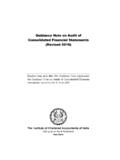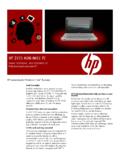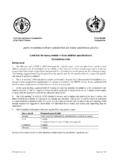Transcription of Application Note AN068 - Texas Instruments
1 Application Note AN068 . Adapting TI LPRF Reference Designs for Layer Stacking By Rea Schmid Keywords Board Stacking for RF Design Matching networks for RF Boards VSWR changes with Stacking Discrete Component Balun Design Bandwidth and Layer Stacking Smith Charts and Balun PCB for CC25xx Devices PCB Traces on Smith Charts 062 Mil Layer Stacking Matching to antenna FR4 Dielectric Material RF Filter Design EM for Low Power Wireless CC24xx, CC25xx Board performance for RF Design . 1 Introduction Texas Instruments provides Evaluation impedance, and vias are discussed in this Modules (EMs) for easy characterization of Application note when changing layer the Low Power RF (LPRF) products. Using stacking. an EM board provides a means to understand the radio's operation and Measuring or validating board changes is decreases the product development time.
2 Especially challenging at high frequencies. Often a customer will copy the EM layout Special equipment such as a VNA or TDR is and then make small changes that can necessary for extracting S-parameters to cause the RF performance to change. One assure the final results are correct. In this of the more common board changes is to Application note the Smith Chart is used as modify the board's layer stacking. For an a tool to derive or validate component RF layout this can change the trace values and trace lengths. Finally the results impedances in the matching network path are compared using 3-D magnetic and lead to degraded system performance. simulation program. To deal with PCB stacking layer changes A 2-layer Evaluation Module (EM) CC2500. one must maintain the trace impedances radio was used to show the steps when when copying an original design.
3 Unlike low changing a board's height from 31 mil ( frequency designs where one simply adjusts mm) to 62 mil ( mm). The 62 mil board a resistor value for a desired voltage level, has the same general RF layout, balun and the RF traces, along with the discrete filter as the original board. components, form a complex impedance matching network. Making sure the Note that different radios ( , CC2520, impedance is the same after making CC2530, etc.) do have different output changes is important to ensure the solution impedances; therefore each requires a works similar to the original. unique matching network. However, the design steps will remain the same. Multi- All TI radios specify recommended load layer boards, however, can require impedance that is found in the data sheet's additional steps. parameter section. This number is used to design the balun and matching network to Finally the tools mentioned in this connect to the antenna.
4 This Application Application note are readily available for note discusses taking a reference design scaling trace lines and plot their and scaling the RF traces when a new impedances. The tools used in this stacking height is desired. Application note were from Agilent's ADS. software package. Many companies have There are many PCB board factors that line calculators and Smith Plotting Tools, so affect RF parameters when designing these feel free to choose what fits your budget. types of networks. The effects of board material, component package, trace SWRA236A Page 1 of 18. Table of Contents KEYWORDS .. 1. 1 INTRODUCTION .. 1. 2 ABBREVIATIONS .. 2. 3 EM 3. 4 CHANGING BOARD STACKING .. 3. INCREASING STACKING HEIGHT ON THE EM 3. 2-SIDED BOARD LAYOUT .. 4. PARAMETERS THAT AFFECT PCB TRACES .. 5. 5 BALUN AND MATCHING FILTER 6. DIFFERENTIAL OUTPUT AND BALUN/MATCHING NETWORK.
5 6. DIFFERENTIAL TO SINGLE-ENDED SOURCE .. 6. BALUN VALUES .. 7. LAYOUT TRACE IMPEDANCES .. 8. 6 CHECKING BALUN VALUES WITH SMITH CHART .. 9. 7 PI MATCHING FILTER AND 50 OHM 11. 8 SOFTWARE SIMULATION 13. 9 POWER SUPPLY 14. 10 LAB 15. BALUN / MATCHING NETWORK 15. RADIO SENSITIVITY 16. TRANSMIT POWER OUTPUT COMPARISON .. 17. SPECTRUM OF IN AND OUT BAND NOISE .. 17. SUMMARY .. 18. 11 REFERENCES .. 18. 12 GENERAL INFORMATION TOOLS AND SOFTWARE .. 18. DOCUMENT HISTORY .. 18. 2 Abbreviations Balun Balanced to unbalanced transformer EM Evaluation Module FR4 PCB board substrate standard LPRF Low Power RF. mil 1 thousandth of an inch mm millimeters PCB Printed Circuit Board RX Receive Mode SMA Coaxial PCB connector TDR Time Domain Reflectometer (test equipment). TEM Transverse Electric Magnetic Mode TX Transmit Mode VNA Vector Network Analyzer (test equipment).
6 XOSC Crystal oscillator SWRA236A Page 2 of 18. 3 EM Purpose A TI LPRF evaluation module (EM) provides a simple evaluation unit to quickly learn the technical operation of a low power wireless radio. The board demonstrates both transmit/receive modes, therefore making it easy to gather link budget information about the device and its antenna. The TI EM is a tested unit and helps to show the engineer a recommended RF layout. Using an EM is good practice and an excellent reference to compare or copy as your final design. TI's EMs along with development tools like SmartRF Studio provides a complete platform for design and measurements. TI EM's provide the following: 1. RX performance measurements ( sensitivity, selectivity, blocking, saturation, spurious emission). 2. TX performance measurements ( output power, occupied bandwidth, adjacent channel power, phase noise, spurious emission).
7 3. Differential to single-ended conversion 4. Matching to antenna's whip, monopoles or chip 5. Proper routing of ground and power returns 6. Low electro magnetic emissions 7. Working Antenna Radio designs require certification depending up on the geographic area. TI EM boards have acceptable levels for radio standards, so if one changes the design they can alter the performance. All CC2500 EM's Gerber files are available on TI web site at: All calculations were done in mils, but can easily be converted to meters by the following expression 1. 1mil = (inch) = m 1000. 4 Changing Board Stacking RF designs are highly dependent upon the signal path from the radio to the antenna. This signal path usually consists of a balun/filter and 50 ohm transmission line. Signal paths can be a combination of discrete and traces or just microstrip traces or some other type of transmission line.
8 This Application note starts with a CC2500 EM with 31 mil ( mm) layer spacing and demonstrates how to change the board's stacking to 62 mil ( mm), while keeping the same RF performance as provided on the original. Increasing Stacking Height on the EM PCB. Before changing or copying a reference designs one should document certain parameters so that after changes are made you can check against the original design. One parameter is VSWR, which is a measurement of how much power is delivered to the reflected. A VSWR of 2 would mean 90% of the power is delivered and the insertion loss is 1 dB. When modifying a reference design here is a list of the steps to follow when changing the board's stacking height: Measure traces: lengths, widths and stacking layers using a Gerber Viewer. Enter values in a Line Calculator to determine the impedances at the original stacking height.
9 Adjust to new stacking height and adjust traces to equivalent impedance as the original. Re-adjust decoupling capacitors for in or out of band spurs or noise as needed. SWRA236A Page 3 of 18. 2-Sided Board Layout A 2-layer board is the easier to deal with than a multi-layer board when considering trace impedances. A two layer board only has a top layer and bottom layer, usually dedicated ground. Multilayer boards have dedicated ground and power planes. Figure 1 shows the original CC2500EM at a layer spacing of 31 mils with top and bottom copper layers. Figure 2. shows a similar 2-layer board with top and bottom copper layer but with thicker core and slightly different power routing. The RF signal path was kept the same on each board while the stacking layer was changed. The RF return path of the power supply was changed on the new board to lower the inductance for power; vias were removed in power traces to lower inductance as shown Figure 2.
10 Both layouts are acceptable solutions. Every attempt was made to keep the ground plane solid and minimize open areas. Top Bottom Figure 1: Original Board Layout Top Bottom Figure 2: Modified Board Layout A 2-layer PCB is cheaper to manufacture than a 4-layer PCB. Both are used in final designs. When doing layout for RF the board stacking layer creates resonances that are proportional to trace or edge lengths. The resonances due to ground planes must be eliminated, and this is done with vias that force the TEM (Transverse Electric Magnetic) resonance frequencies higher. A sufficient amount of vias must be used to short the top ground to the bottom ground. These vias are usually selected so the board resonances frequencies are higher than the 10th or 12th harmonics of the radio signal c frequency. As example fres = *10 or GHz, then l via =.
















